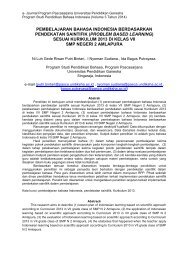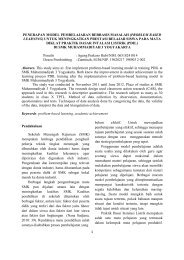You also want an ePaper? Increase the reach of your titles
YUMPU automatically turns print PDFs into web optimized ePapers that Google loves.
The periodic table<br />
The periodic table<br />
● Electron structure and the<br />
periodic table<br />
The elements are placed in the periodic table in order of increasing<br />
atomic number (the number of protons). The diagram shows the first<br />
36 elements in the periodic table.<br />
Group<br />
1<br />
Group<br />
2<br />
Group<br />
3<br />
Group<br />
4<br />
Group<br />
5<br />
Group<br />
6<br />
Group<br />
7<br />
Group<br />
0<br />
3<br />
Li<br />
11<br />
Na<br />
19<br />
K<br />
4<br />
Be<br />
12<br />
Mg<br />
20<br />
Ca<br />
21<br />
Sc<br />
22<br />
Ti<br />
23<br />
V<br />
24<br />
Cr<br />
25<br />
Mn<br />
26<br />
Fe<br />
1<br />
H<br />
27<br />
Co<br />
28<br />
Ni<br />
29<br />
Cu<br />
30<br />
Zn<br />
5<br />
B<br />
13<br />
Al<br />
31<br />
Ga<br />
6<br />
C<br />
14<br />
Si<br />
32<br />
Ge<br />
7<br />
N<br />
15<br />
P<br />
33<br />
As<br />
8<br />
O<br />
16<br />
S<br />
34<br />
Se<br />
9<br />
F<br />
17<br />
Cl<br />
35<br />
Br<br />
2<br />
He<br />
10<br />
Ne<br />
18<br />
Ar<br />
36<br />
Kr<br />
The table can be seen as arranging the elements by electron structure.<br />
Across each period each energy level (shell) is gradually filled, with the<br />
next shell being filled in the next period. The electron structure of the<br />
first 20 elements is shown here.<br />
Group<br />
1<br />
Group<br />
2<br />
Group<br />
3<br />
Group<br />
4<br />
Group<br />
5<br />
Group<br />
6<br />
Group<br />
7<br />
Group<br />
0<br />
2,1 2,2<br />
Li Be<br />
2,8,1 2,8,2<br />
Na Mg<br />
2,8,8,1 2,8,8,2<br />
K Ca<br />
1<br />
H<br />
2,3<br />
B<br />
2,8,3<br />
Al<br />
2,4<br />
C<br />
2,8,4<br />
Si<br />
2,5<br />
N<br />
2,8,5<br />
P<br />
2,6<br />
O<br />
2,8,6<br />
S<br />
2,7<br />
F<br />
2,8,7<br />
Cl<br />
2<br />
He<br />
2,8<br />
Ne<br />
2,8,8<br />
Ar<br />
TIP<br />
In Group 0 all the elements have full<br />
outer shells. Helium has 2 elctrons in<br />
its outer shell while the other elements<br />
have got 8 electrons in their outer<br />
shells.<br />
Elements in the same group have the same number of electrons in<br />
their outer shell. The number of electrons in the outer shell equals<br />
the Group number. For example, all the elements in Group 1 have 1<br />
electron their outer shell (Li = 2,1; Na = 2,8,1; K = 2,8,8,1). All the<br />
elements in Group 7 have 7 electrons in their outer shell (F = 2,7;<br />
Cl = 2,8,7). The only exception to this is Group 0 where elements have<br />
a full outer shell.<br />
All the elements in the same group have similar chemical properties<br />
because they have the same number of electrons in their outer shell.<br />
The chemical properties of the elements in the periodic table repeat at<br />
regular (periodic) intervals. This is why it is called the periodic table.<br />
13





